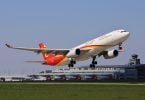China’s airlines are heading into calmer skies after a difficult couple of years thanks to crucial government support. It won’t be the last time Beijing’s help is needed.
The big three Chinese carriers—Air China, China Southern and China Eastern — are still working to repair balance sheets hit hard back in 2008, when a series of bad bets on fuel-hedging derivatives went spectacularly wrong.
But they are making progress. Air China last week said it plans to raise $952 million in a private share placement. That followed an earlier announcement by China Southern that it would raise $1.6 billion via a similar transaction. In each case, the companies’ state-owned parents stepped in to provide the core funds.
Things are looking up even for China Eastern, whose debt-to-equity ratio still approaches four figures despite crucial government fund injections last year.
Its search for a strategic investor goes on, but 2010 should provide some good opportunities. CEA expects to join one of the world’s leading airline alliances by the end of April. Its recent acquisition of Shanghai Airlines — helpfully green-lighted by the government — will help grow its market share in a year that China’s second city hosts the World Expo.
The fundamental demand picture for each of the airlines is improving in line with China’s relatively buoyant economy. Traffic numbers have already been rising for several months: China’s airline regulator expects domestic passenger levels — the key revenue source for every major Chinese airline — to rise by 13% this year.
Such solid passenger growth over the next two to three years will be a much needed cushion for the airlines. From 2012 onwards an expanded high-speed rail network is set to provide a stiff challenge to air travel. For crucial routes such as Beijing-to-Shanghai, trains could offer a more convenient, and still speedy, mode of travel for passengers.
Certainly if high-speed train prices are set much lower than air fares, airlines will face a strong competitive threat. Planned extra capacity in the next few years – Air China alone says it could add 400 new planes in the next five to six years – might then become redundant.
Once the competitive challenge from trains gains steam, Chinese airlines may need the government again to help keep the playing field level. The comfort of knowing Beijing stands ready to propel them out of trouble is likely to continue to shield them from the need to optimize efficiency.






















